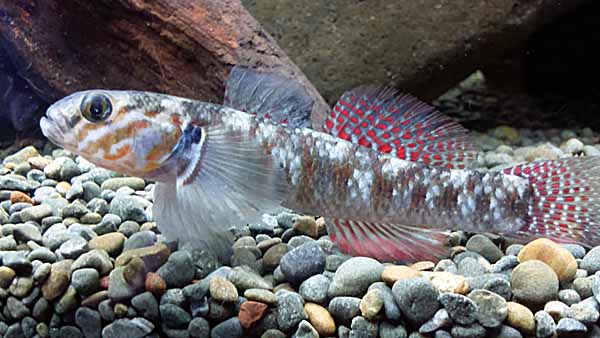Gobiomorphus huttoni
(Ogilby, 1894)
|
Familie: Eleotridae SynonymeEleotris huttoni Ogilby, 1894 Lokale Bezeichnung |
Typen
Holotypus: AMS I.3162 .
Siehe: Eschmeyer, W.N., Fricke, R. & Van der Laan, R. (eds.) 2024. Catalog of Fishes electronic version
Typusfundort: Waikato River, Neuseeland.
Etymologie
Benannt zu Ehren von Kapitän Frederick Wollaston Hutton (1836-1905), Armeeoffizier und Naturforscher, "dessen Forschungen so viel zur Erhellung der Geschichte der neuseeländischen Fische beigetragen haben" .
Verbreitung
Neuseeland.
IUCN Status

EX Extinct (ausgestorben)
EW Extinct in the Wild (in der Natur ausgestorben)
CR Critically Endangered (vom Aussterben bedroht)EN Endangered (stark gefährdet)
VU Vulnerable (gefährdet)
NT Near Threatened (potenziell gefährdet)
LC Least Concern (nicht gefährdet)
RE Regionally Extinct (regional oder national ausgestorben)DD Data Deficient (ungenügende Datengrundlage)
NE Not Evaluated (nicht beurteilt)
NT Near Threatened (potenziell gefährdet)
Gefahren für diese Art: Der Verlust und die Veränderung von Lebensräumen sind die Hauptursachen für die Bedrohung dieser Art. Der Verlust der Ufervegetation und die zunehmende Sedimentation führen wahrscheinlich zu einer Verringerung der Deckung in den Flüssen, zu einer Veränderung der Wassertemperatur und zu einer Verringerung des Fütterungserfolgs. Künstliche Hindernisse für die Wanderung, insbesondere unterspülte Durchlässe und Staudämme, unterbrechen die Verbindung zwischen den Flüssen und den Zugang zu den Lebensräumen der ausgewachsenen Tiere. Außerdem besteht eine potenzielle Bedrohung durch Prädation und Konkurrenz durch eingeführte Salmoniden, vor allem Bachforellen (Salmo trutta).
Literatur
- Ogilby, J.D. 1894. Description of five new fishes from the Australasian region. Proceedings of the Linnean Society of New South Wales, Series 2, 9 (2): 367–374. (BHL Zitatseite [:369, !!, als Eleotris huttoni]
- McDowall, R.M. 1964. Studies on the biology of the red-finned bully Gobiomorphus huttoni (OGILBY) Part I. - Habitat and species inter-relationships. Transactions of the Royal Society of New Zealand, Zoology, 4 (12): 175-182. Zitatseite [:175-182|Fortpflanzung ]
- McDowall, R.M. 1965. Studies on the biology of the red-finned bully Gobiomorphus huttoni (OGILBY) Part II. - Breeding and life history. Transactions of the Royal Society of New Zealand, Zoology, 5 (14): 177-196. Zitatseite [:177-196|Fortpflanzung ]
- McDowall, R.M. 1965. Studies on the biology of the red-finned bully Gobiomorphus huttoni (OGILBY) Part III. - Food studies. Transactions of the Royal Society of New Zealand, Zoology, 5 (17): 233-254. Zitatseite [:233-254|Fortpflanzung ]
- McDowall, R.M. 1975. A revision of the New Zealand species of Gobiomorphus (Pisces: Eleotridae). National Museum of New Zealand Records, 1 (1): 1-32. Zitatseite [:8, als Gobiomorphus huttoni]
- Paulin, C., Stewart, A., Roberts, C., McMillan, P. 1989. New Zealand fish: a complete guide, miscellaneous series 19. Wellington: National Museum of New Zealand. Zitatseite [:224]
- Bleher, H. 1991. Zum ersten "zivilisierten, elektronischen Fischfang" in Neuseeland. Aquarium Heute, 9 (1): 47-49. Zitatseite [:49|Farbfoto ]
- Horsthemke, H. 1991. Eine farbenprächtige Schläfergrundel aus Neuseeland - Gobiomorphus huttoni (Ogilby, 1894). Das Aquarium, #269, (11): 9-15. Zitatseite [:9-15|Farbfoto, Vorkommen, Beschreibung ]
- Baensch, H.A. 1997. Aquarien Atlas, Band 5 (1. Auflage). Mergus Verlag, Melle. 1148pp. Zitatseite [:1022f|Farbfoto, Synonyme ]
- Larson, H.K. 2011. The marine temperate gobioids of southern Australia and the New Zealand region. Chapter 2.4. Pp. 235–241. in:
- Patzner, R.A., van Tassell, J.L., Kovacic, M. & Kapoor, B.G. (eds.) 2011. The biology of gobies. CRC Press, Science Publishers, Enfield, N. H. Zitatseite [:239]
- McDowall, R.M. & Stewart, A.L. 2015. 221 Family Eleotridae (pp. 1562-1572). In:
- Roberts, C. D., Stewart, A.L. & Struthers, C.D. (eds) 2015. The Fishes of New Zealand. Zitatseite Zitatseite [:1570]
- Thacker, C.E., Shelley, J.J., McCraney, W.T., Unmack, P.J. & McGee, M.D. 2021. Delayed Adaptive Radiation among New Zealand Stream Fishes: Joint Estimation of Divergence Time and Trait Evolution in a Newly Delineated Island Species Flock. Systematic Biology, 71 (1) [2022]: 13–23. (doi) Zitatseite [:15, Fig 1, Farbfoto, Phylogenie]
